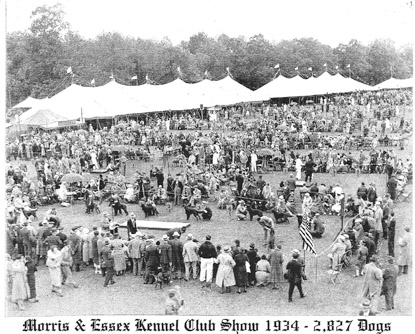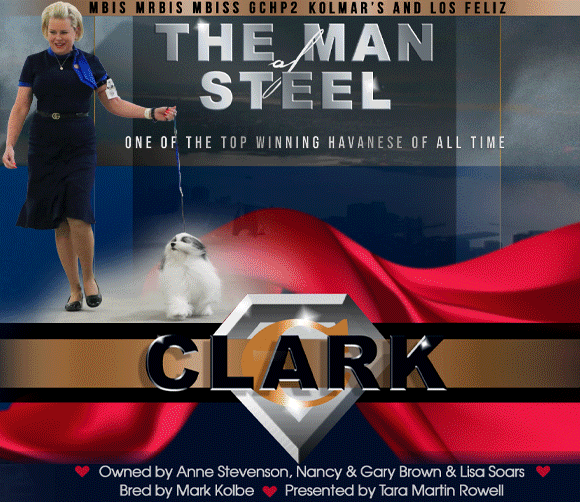Morris & Essex Top Dogs
by Joan Harrigan
Photos courtesy of Morris & Essex Kennel Club
Originally published June 2010
 Showing dogs today is rarely glamorous. Aside from the moments in the ring and a chance to catch up with friends, there’s a lot of back-breaking work and too little time. Too often, exhibitors leave a show with no idea of what happened in the groups, much less which dog went Best In Show. It’s understandable – most dog fanciers have jobs, families and responsibilities waiting for them at home. And most have never experienced the grandeur and scope of the great dog shows of the past.
Showing dogs today is rarely glamorous. Aside from the moments in the ring and a chance to catch up with friends, there’s a lot of back-breaking work and too little time. Too often, exhibitors leave a show with no idea of what happened in the groups, much less which dog went Best In Show. It’s understandable – most dog fanciers have jobs, families and responsibilities waiting for them at home. And most have never experienced the grandeur and scope of the great dog shows of the past.
Only a few shows provide a window into that past. Thanks to the vision of Wayne Ferguson and the nearly 400 devoted and diverse members of the revived Morris & Essex Kennel Club of New Jersey, every five years the great Morris & Essex Kennel Club Show reappears to remind us of lost traditions. This year, the show takes place Thursday, October 7 on the meticulously manicured grounds of Colonial Park, Franklin Township, New Jersey. Clearly, this is a different type of show. With its archival exhibits, fabulous bank of trophies, and dedication to tradition, Morris & Essex invites exhibitors to take time to appreciate the moment and the joy of purebred dogs.
First held in 1927, Morris & Essex was legendary for its size (more than 4,000 entries from 1937 through 1940), quality and elegance. The show was orchestrated and financed by Geraldine Rockefeller Dodge and held on the polo fields of Hartley Farms, her husband’s estate in Harding Township, New Jersey. The list of Best In Show winners contains familiar names from the past, among them 1939’s winner, the Cocker Spaniel Ch. My Own Brucie, who was called the “most photographed dog in the world,” and who contributed to the cocker’s place as America’s most popular breed of the time.
As for elegance – Mrs. Dodge sent cars to the train station to transport arriving exhibitors and suspended judging for exactly an hour so that judges and exhibitors alike could enjoy the box lunch she provided. Everything about the show reflected her taste and style – the trophies were sterling silver and the attire was far from casual. The 1934 show catalog was hard-covered cloth bound – another Morris & Essex first.
Billy Gorodner of Leesburg, Virginia, serves as one of two historians for the revived Morris & Essex Kennel Club. Gorodner grew up in New York and New Jersey, and was mentored by Sunny Shay of Grandeur Afghans. Their friendship began when she heard him praise one of her dogs to his parents during the judging at Westminster, his second dog show. “The child has an eye,” Shay told his surprised parents, and she invited him to visit her kennel in Carmel, New York. That first visit led to many others, and “that was where I learned about dogs,” Gorodner recalls.
The teen-aged Gorodner was at the final Morris & Essex in 1957, when the Miniature Poodle, Ch. Fircot L’Ballerine of Maryland went Best In Show. He recalls the calm atmosphere and the ringside cocktail party after Best In Show. He was back for the show’s rebirth in 2000 and again in 2005, and his partner, the late Lloyd Alton announced both events. The winners in 2000 and 2005 were two terriers that will be remembered years after their wins – very different dogs, each memorable in his way.
Best In Show 2000 – Torums Scarf Michael (Kerry Blue Terrier). Eleven of the original 26 Morris & Essex shows were won by terriers, so it was perhaps fitting that the first show of its reincarnation was won by a Kerry Blue fresh from his victory at Crufts. Torums Scarf Michael, the legendary “Mick,” finished his American championship at Morris & Essex, then won the show and repeated the win later in the weekend, at the Montgomery. “He was the best, “says Gorodner. “Right in his prime at the time.”
Carol Brown of Bluebeard Kerry Blues in Pipersville, Pennsylvania, a Morris & Essex member, first saw Mick at Crufts when he was a puppy. “He was still black, he was on the grooming table and he was not happy about it,” she laughs. “A lot of people didn’t realize what they were looking at. But he was having fun – he loved being at the show.” Brown took note of his “amazing head, fantastic outline and flawless movement.” Mick had just what she thought was needed in the breed back home, and she made a point of bringing other American Kerry fanciers over to see him.
Brown later imported Mick’s semen for use in her line and told handler Bill McFadden that this was a dog that he had to see. They returned to Crufts to watch Mick win – and then go Best In Show at Morris & Essex and Montgomery in 2000 and Westminster in 2003.
Billy Gorodner remembers seeing Mick again at the Old Dominion Show, where he sat with Cocker Spaniel breeder Jack Ward. “Jack had lost his sight to macular degeneration and we used to describe the dogs to him,” Gorodner says. “We asked Bill McFadden to bring Mick over so that Jack could go over him. There wasn’t a dry eye as we watched his hands on that dog.” McFadden then asked Gorodner if he would like to examine the dog – “he was breathtaking,” Gorodner says with a catch in his voice. “I never felt a rear on a dog equal to his.”
David Frei, breeder, judge, veteran Westminster commentator and Morris & Essex member, seconds Gorodner’s assessment. “He was maybe the greatest show dog we’ve seen in the last 30 years,” he says. “He was always right on the edge – that’s what made him such a magnificent stallion of a dog.”
Best in Show 2005 – Ch. Rocky Top’s Sundance Kid (Colored Bull Terrier). In 2005, Morris & Essex’s Best In Show again went to the winner of the Terrier Group – the charismatic Rufus, Ch. Rocky Top’s Sundance Kid. “It felt like the Triple Crown,” owner Barbara Bishop remembers. “He won this, then the National Dog Show and then Westminster. I couldn’t have asked him for anything more.”
“Morris & Essex was quite unexpected,” Bishop continues. “Mick, one of the greatest dogs that ever lived, was back for this show, and Walter Goodman, my ‘god of terriers,’ was judging the group. I have the greatest respect for Michele Billings, the Best In Show judge. It was really profound.”
Rufus, now 10 and retired at home with Bishop and her husband, is by no means inactive. “After retirement, he would run to the door and block it with his body when I tried to leave,” Bishop laughs. “He has a great personality and loves attention.” Clearly, Rufus was not ready for a life of relaxation, so Bishop and he were certified as a team by Therapy Dogs International. They visit a nursing home each week, as well as libraries and schools.
“We were given a gift, and now we’re giving back,” Bishop says. Rufus has done a lot to correct the public’s misperception of “bully breeds.” “People used to cross the street to avoid us; now they cross to come over to pet Rufus. He’s making people aware that the breed is not the issue.”
Bishop is now showing Rufus’ grandchildren, but continues to take him along to the shows he enjoys so much. “He’ll be back at Morris & Essex, at least for a visit,” she says. “There’s talk of having him come into the ring before Best In Show judging.” And why not – it would be a fitting tribute to a great show dog and companion, and a passing of the torch to the next generation.
The Future
Morris & Essex historian Billy Gorodner speaks eloquently about the loss of history and tradition in the dog fancy. “To me, history is not remembering exact dates, but rather the concepts. It is important to know what came before.” He remembers seeing Mrs. Dodge and thinking that “no royalty looked more royal than she.” However, he points out “the great breeders of the past always looked to the future. They were radicals, including Mrs. Dodge.”
Gorodner sees Morris & Essex as a way to recapture the spirit and traditions of the past, while uniting today’s breeders and fanciers with the common goal of preserving purebred dog breeding for future generations. “We must come together,” he emphasizes. “Or all this will be lost.”
Short URL: https://caninechronicle.com/?p=278727
Comments are closed












